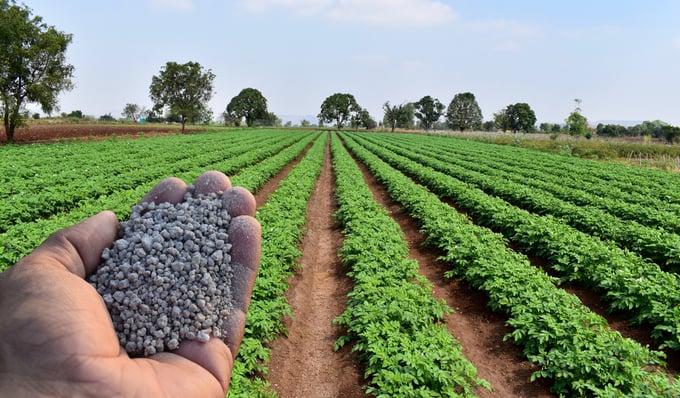June 24, 2025 | 03:21 GMT +7
June 24, 2025 | 03:21 GMT +7
Hotline: 0913.378.918
June 24, 2025 | 03:21 GMT +7
Hotline: 0913.378.918

It’s well known that fertilizer use is a culprit in greenhouse gas emissions, but now we have a sense of how much and when emissions are triggered.
Fertilizer. It’s a major contributor of greenhouse gases, accounting for roughly two percent of global emissions and 10 percent of agriculture’s environmental footprint.
But now, a group of researchers from the U.K. has built a roadmap that quantifies the source of emissions and outlines what reduction methods are possible. The study, published in Nature Food, found that two-thirds of all greenhouse gas emissions take place after fertilizers are applied onto cropland, while one-third of emissions result from fertilizer production. A combination of technical, agricultural and policy interventions in both areas, however, could reduce emissions by as much as 80 percent by 2050, the study found.
Researchers say increasing the efficiency of fertilizer use is the single most effective strategy to reduce emissions. Precision agriculture, the timing of application, using improved plant breeds that better utilize fertilizer and adopting improved irrigation methods are outlined as ways to reduce emissions by nearly 50 percent.
They suggest that replacing some of the fertilizers with the highest emissions, such as urea with ammonium nitrate, could reduce emissions by anywhere between 20 percent and 30 percent. Fertilizers could be mixed with chemicals called nitrification inhibitors, which prevent bacteria from forming nitrous oxide, resulting in an emission reduction between 42 percent and 55 percent.
The research is the first of its kind to make the calculations from petrochemical production to farm application. Notably, findings also revealed that manure and synthetic fertilizers emit the equivalent of 2.6 gigatonnes of carbon per year—more than emitted by global aviation and shipping combined.
“I see this opening the door to a lot of other important questions of how we can best reduce the amount of fertilizer as much as we can, without any loss in productivity of crops,” says André Cabrera Serrenho, a co-author of the paper and assistant professor for Cambridge University’s Department of Engineering. “This is what matters at the end of the day, and we have started to paint a clearer picture of it all.”
Both the production and use of fertilizers, particularly nitrogen fertilizer, release carbon dioxide, nitrous oxide and methane. Natural gas, coal and oil are used as feedstock and fuels for the production of ammonia, a crucial ingredient in fertilizer. These gases are also released from the extraction and combustion of these fuels as well as the product of chemical reactions. Additional emissions result from the generation of electricity used to drive the compressors and pumps.
When fertilizers are used on cropland, nitrous oxide is generated through a chemical reaction between soil bacteria and the fertilizer via nitrification and denitrification. Carbon dioxide is also produced as urea and ammonium bicarbonate break down in the soil.
The paper states that its recommendations will only be worthwhile if the fertilizer industry takes steps to decarbonize—a specific area where public and private investment could also be beneficial. Electrolysis could be used to supply hydrogen in replacing ammonia synthesis, where up to 27 percent of total emissions could see a reduction. Electrifying the production process using electric heating also has the potential to reduce 21 percent of total emissions by avoiding fuel combustion. Carbon capture and storage was also outlined as having the potential to reduce current emissions by 25 percent by 2050.
Cabrera Serrenho says he hopes the research helps facilitate better public policy towards emission reductions.
“Farming is an incredibly tough business at the moment,” he says. “There are very few incentives right now for both farmers and fertilizer companies to care about emissions or to tackle fertilizer use because it’s largely driven by costs. I believe our research highlights some need for incentives to facilitate behavior. ”
The study’s findings come against a backdrop of widespread global inflation, and countries such as Holland, New Zealand and Canada face political tensions with farmers who fear agriculture emission reduction policies will curtail food production and, in turn, their profits. But for the U.S., where the Biden administration has been clear that net-zero emissions will require adjusting agricultural systems, the study’s recommendations present a possible way forward.
Cabrera Serrenho says the new study only scratches the surface of what’s possible. Right now, he’s keen on exploring the impact of specific dietary changes on fertilizer use and emissions.
“It’s worth pointing out that we still have 20 percent of emissions that haven’t been accounted for, that we don’t know how we could possibly eliminate [them],” he says. “This is important and yet concerning as we set out to make food systems more sustainable.”
(Modernfarmer)

(VAN) Poultry production in Poland, which has only started recovering from devastating bird flu outbreaks earlier this year, has been hit by a series of outbreaks of Newcastle disease, with the veterinary situation deteriorating rapidly.

(VAN) Extensive licensing requirements raise concerns about intellectual property theft.

(VAN) As of Friday, a salmonella outbreak linked to a California egg producer had sickened at least 79 people. Of the infected people, 21 hospitalizations were reported, U.S. health officials said.

(VAN) With the war ongoing, many Ukrainian farmers and rural farming families face limited access to their land due to mines and lack the financial resources to purchase needed agricultural inputs.

(VAN) Vikas Rambal has quietly built a $5 billion business empire in manufacturing, property and solar, and catapulted onto the Rich List.

(VAN) Available cropland now at less than five percent, according to latest geospatial assessment from FAO and UNOSAT.

(VAN) Alt Carbon has raised $12 million in a seed round as it plans to scale its carbon dioxide removal work in the South Asian nation.